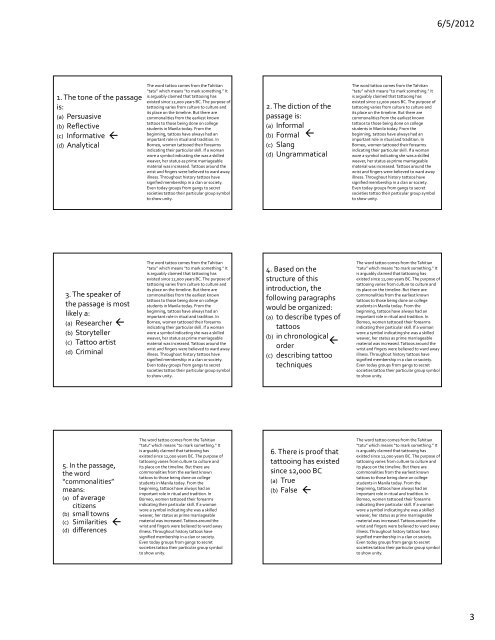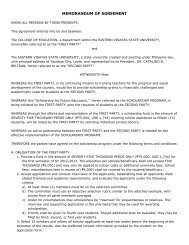PDF handout of the 32 Powerpoints - Mark Fullmer
PDF handout of the 32 Powerpoints - Mark Fullmer
PDF handout of the 32 Powerpoints - Mark Fullmer
You also want an ePaper? Increase the reach of your titles
YUMPU automatically turns print PDFs into web optimized ePapers that Google loves.
6/5/20121. The tone <strong>of</strong> <strong>the</strong> passageis:(a) Persuasive(b) Reflective(c) Informative (d) AnalyticalThe word tattoo comes from <strong>the</strong> Tahitian“tatu” which means “to mark something.” Itis arguably claimed that tattooing hasexisted since 12,000 years BC. The purpose <strong>of</strong>tattooing varies from culture to culture andits place on <strong>the</strong> timeline. But <strong>the</strong>re arecommonalities from <strong>the</strong> earliest knowntattoos to those being done on collegestudents in Manila today. From <strong>the</strong>beginning, tattoos have always had animportant role in ritual and tradition. InBorneo, women tattooed <strong>the</strong>ir forearmsindicating <strong>the</strong>ir particular skill. If a womanwore a symbol indicating she was a skilledweaver, her status as prime marriageablematerial was increased. Tattoos around <strong>the</strong>wrist and fingers were believed to ward awayillness. Throughout history tattoos havesignified membership in a clan or society.Even today groups from gangs to secretsocieties tattoo <strong>the</strong>ir particular group symbolto show unity.2. The diction <strong>of</strong> <strong>the</strong>passage is:(a) Informal(b) Formal (c) Slang(d) UngrammaticalThe word tattoo comes from <strong>the</strong> Tahitian“tatu” which means “to mark something.” Itis arguably claimed that tattooing hasexisted since 12,000 years BC. The purpose <strong>of</strong>tattooing varies from culture to culture andits place on <strong>the</strong> timeline. But <strong>the</strong>re arecommonalities from <strong>the</strong> earliest knowntattoos to those being done on collegestudents in Manila today. From <strong>the</strong>beginning, tattoos have always had animportant role in ritual and tradition. InBorneo, women tattooed <strong>the</strong>ir forearmsindicating <strong>the</strong>ir particular skill. If a womanwore a symbol indicating she was a skilledweaver, her status as prime marriageablematerial was increased. Tattoos around <strong>the</strong>wrist and fingers were believed to ward awayillness. Throughout history tattoos havesignified membership in a clan or society.Even today groups from gangs to secretsocieties tattoo <strong>the</strong>ir particular group symbolto show unity.3. The speaker <strong>of</strong><strong>the</strong> passage is mostlikely a:(a) Researcher (b) Storyteller(c) Tattoo artist(d) CriminalThe word tattoo comes from <strong>the</strong> Tahitian“tatu” which means “to mark something.” Itis arguably claimed that tattooing hasexisted since 12,000 years BC. The purpose <strong>of</strong>tattooing varies from culture to culture andits place on <strong>the</strong> timeline. But <strong>the</strong>re arecommonalities from <strong>the</strong> earliest knowntattoos to those being done on collegestudents in Manila today. From <strong>the</strong>beginning, tattoos have always had animportant role in ritual and tradition. InBorneo, women tattooed <strong>the</strong>ir forearmsindicating <strong>the</strong>ir particular skill. If a womanwore a symbol indicating she was a skilledweaver, her status as prime marriageablematerial was increased. Tattoos around <strong>the</strong>wrist and fingers were believed to ward awayillness. Throughout history tattoos havesignified membership in a clan or society.Even today groups from gangs to secretsocieties tattoo <strong>the</strong>ir particular group symbolto show unity.4. Based on <strong>the</strong>structure <strong>of</strong> thisintroduction, <strong>the</strong>following paragraphswould be organized:(a) to describe types <strong>of</strong>tattoos(b) in chronologicalorder(c) describing tattootechniquesThe word tattoo comes from <strong>the</strong> Tahitian“tatu” which means “to mark something.” Itis arguably claimed that tattooing hasexisted since 12,000 years BC. The purpose <strong>of</strong>tattooing varies from culture to culture andits place on <strong>the</strong> timeline. But <strong>the</strong>re arecommonalities from <strong>the</strong> earliest knowntattoos to those being done on collegestudents in Manila today. From <strong>the</strong>beginning, tattoos have always had animportant role in ritual and tradition. InBorneo, women tattooed <strong>the</strong>ir forearmsindicating <strong>the</strong>ir particular skill. If a womanwore a symbol indicating she was a skilledweaver, her status as prime marriageablematerial was increased. Tattoos around <strong>the</strong>wrist and fingers were believed to ward awayillness. Throughout history tattoos havesignified membership in a clan or society.Even today groups from gangs to secretsocieties tattoo <strong>the</strong>ir particular group symbolto show unity.5. In <strong>the</strong> passage,<strong>the</strong> word“commonalities”means:(a) <strong>of</strong> averagecitizens(b) small towns(c) Similarities(d) differencesThe word tattoo comes from <strong>the</strong> Tahitian“tatu” which means “to mark something.” Itis arguably claimed that tattooing hasexisted since 12,000 years BC. The purpose <strong>of</strong>tattooing varies from culture to culture andits place on <strong>the</strong> timeline. But <strong>the</strong>re arecommonalities from <strong>the</strong> earliest knowntattoos to those being done on collegestudents in Manila today. From <strong>the</strong>beginning, tattoos have always had animportant role in ritual and tradition. InBorneo, women tattooed <strong>the</strong>ir forearmsindicating <strong>the</strong>ir particular skill. If a womanwore a symbol indicating she was a skilledweaver, her status as prime marriageablematerial was increased. Tattoos around <strong>the</strong>wrist and fingers were believed to ward awayillness. Throughout history tattoos havesignified membership in a clan or society.Even today groups from gangs to secretsocieties tattoo <strong>the</strong>ir particular group symbolto show unity.6. There is pro<strong>of</strong> thattattooing has existedsince 12,000 BC(a) True(b) FalseThe word tattoo comes from <strong>the</strong> Tahitian“tatu” which means “to mark something.” Itis arguably claimed that tattooing hasexisted since 12,000 years BC. The purpose <strong>of</strong>tattooing varies from culture to culture andits place on <strong>the</strong> timeline. But <strong>the</strong>re arecommonalities from <strong>the</strong> earliest knowntattoos to those being done on collegestudents in Manila today. From <strong>the</strong>beginning, tattoos have always had animportant role in ritual and tradition. InBorneo, women tattooed <strong>the</strong>ir forearmsindicating <strong>the</strong>ir particular skill. If a womanwore a symbol indicating she was a skilledweaver, her status as prime marriageablematerial was increased. Tattoos around <strong>the</strong>wrist and fingers were believed to ward awayillness. Throughout history tattoos havesignified membership in a clan or society.Even today groups from gangs to secretsocieties tattoo <strong>the</strong>ir particular group symbolto show unity.3







